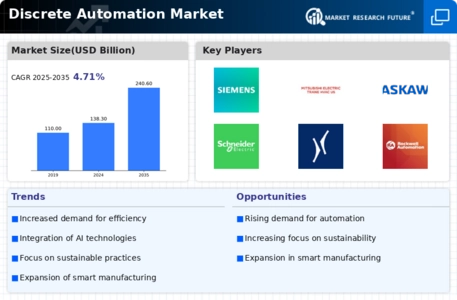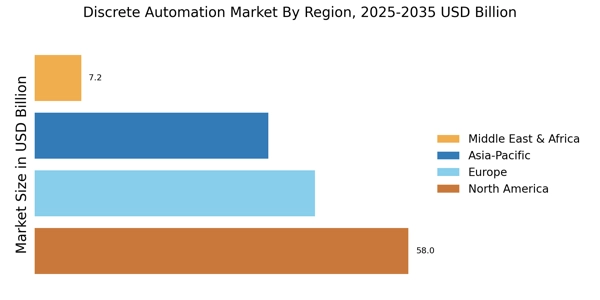Rising Demand for Automation Solutions
The increasing demand for automation solutions across various industries is a primary driver of the Discrete Automation Market. As manufacturers seek to enhance productivity and efficiency, the adoption of automation technologies has surged. According to recent data, the market for discrete automation is projected to grow at a compound annual growth rate of approximately 8.5% over the next five years. This growth is fueled by the need for reduced operational costs and improved quality control. Industries such as automotive, electronics, and consumer goods are particularly focused on integrating automation to streamline their processes. The Discrete Automation Market is thus witnessing a robust expansion as companies invest in advanced automation systems to remain competitive.
Technological Advancements in Robotics
Technological advancements in robotics are significantly influencing the Discrete Automation Market. Innovations in robotic systems, including collaborative robots and artificial intelligence, are enabling manufacturers to automate complex tasks with greater precision and flexibility. The integration of advanced robotics is expected to enhance production capabilities, allowing for faster turnaround times and reduced labor costs. Recent estimates suggest that the robotics segment within the discrete automation market could account for over 30% of the total market share by 2026. As industries increasingly adopt these technologies, the Discrete Automation Market is likely to experience substantial growth driven by the need for smarter and more efficient manufacturing solutions.
Increased Focus on Operational Efficiency
The heightened focus on operational efficiency is a critical driver of the Discrete Automation Market. Companies are increasingly recognizing the importance of optimizing their operations to remain competitive in a rapidly evolving market. This trend is leading to a surge in investments in automation technologies that can streamline processes, reduce waste, and enhance overall productivity. Data indicates that organizations implementing discrete automation solutions can achieve efficiency improvements of up to 30%. As businesses strive to maximize their output while minimizing costs, the Discrete Automation Market is poised for continued growth, driven by the demand for innovative solutions that enhance operational performance.
Regulatory Compliance and Safety Standards
Regulatory compliance and safety standards are becoming increasingly stringent across various industries, driving the growth of the Discrete Automation Market. Companies are compelled to adopt automation solutions that not only enhance productivity but also ensure compliance with safety regulations. The implementation of automated systems can significantly reduce the risk of human error and improve workplace safety. As industries such as food and beverage, pharmaceuticals, and chemicals face rigorous regulatory scrutiny, the demand for compliant automation solutions is expected to rise. This trend is likely to propel the Discrete Automation Market forward, as businesses prioritize safety and compliance in their operational strategies.
Growing Need for Customization in Manufacturing
The growing need for customization in manufacturing processes is shaping the Discrete Automation Market. As consumer preferences evolve, manufacturers are increasingly required to produce tailored products in smaller batches. This shift necessitates flexible automation solutions that can adapt to varying production requirements. The market for discrete automation is expected to expand as companies invest in technologies that allow for greater customization without sacrificing efficiency. Recent trends suggest that the demand for customized automation solutions could lead to a market growth rate of around 7% annually. Consequently, the Discrete Automation Market is likely to thrive as manufacturers seek to meet the diverse needs of their customers.


















Leave a Comment